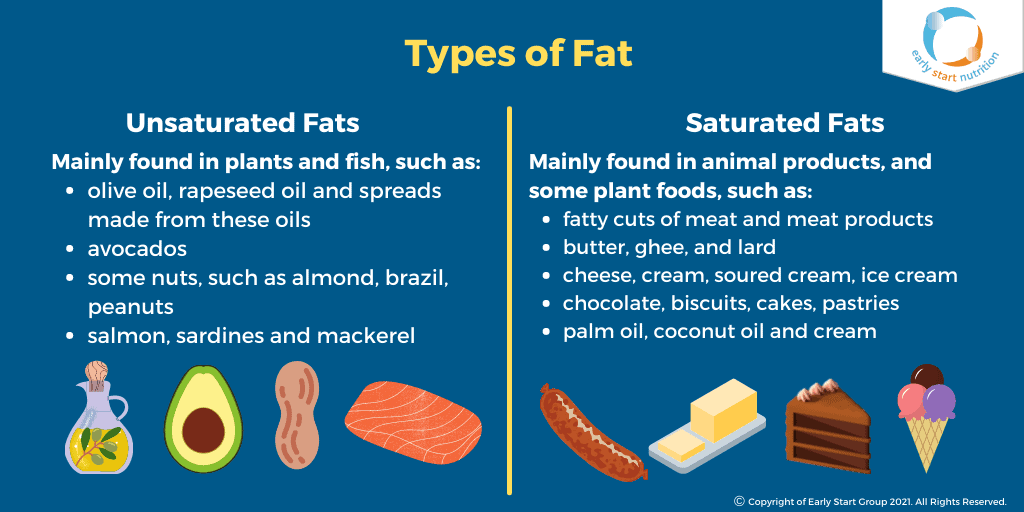In this blog we’ll be exploring what types of fat are best.
A small amount of fat is an essential part of a healthy, balanced diet. They’re a source of essential fatty acids, which our bodies cannot make themselves. Fat also helps our bodies to absorb vitamin A, vitamin D and vitamin E. These vitamins are fat-soluble, which means they can only be absorbed with the help of fats.
Any fat that’s not used by our bodies or turned into energy is converted into body fat. Likewise, unused carbohydrates and proteins are also converted into body fat.
All types of fat are high in energy. A gram of fat, whether it’s saturated or unsaturated, provides 9kcal (37kJ) of energy compared with 4kcal (17kJ) for carbohydrate and protein.
What types of fat are best?
The main types of fat found in food are:

Unsaturated fats are healthier forms of fat, as they provide us with important fatty acids and fat soluble vitamins.
There’s good evidence that replacing saturated fats with some unsaturated fats can help to lower our cholesterol level.
How much fat?
The maximum recommended daily amounts of saturated fat are:
Men are advised to have no more than 30g of saturated fat a day
Women are advised to have no more than 20g of saturated fat a day
Children aged 11+ should have no more than 28g of saturated fat a day
Children aged 7-10 should have no more than 22g of saturated fat a day
Children aged 4-6 should have no more than 18g of saturated fat a day
Children under 4– no guidelines, but it’s recommended to limit their saturated fat intake.
Which oils are best to cook with?
If you use oil at home during cooking, try to select oils such as rapeseed, vegetable or olive oil as these contain more unsaturated fats.
In recent years, oils, such as coconut oil, have become a popular choice to use in cooking and are often promoted as a healthy choice on social media. However, coconut oil has a saturated fat content of around 86 per cent, about a third more saturated fat than butter (52 per cent)! It’s therefore not recommended for daily use.
When cooking with oil, it’s best to choose an oil with a high smoke point. This means the oil can withstand higher temperatures before the fats start to break down and changes in flavour. Good oils to use at high temperatures are rapeseed oil, peanut oil or sunflower oil.
Tips to reduce your fat intake:
- Limit the use of saturated fats, such as butter, lard, suet, ghee, coconut oil and palm oil, and instead opt for unsaturated fats, such as vegetable oil, rapeseed oil and olive oil and lower fat vegetables based spreads.
- Measure oil when cooking- one teaspoon per person or one tablespoon for a family of four or try using a spray oil
- Avoid adding extra oil or butter when cooking, and instead try stir frying, grilling, baking, steaming, poaching or using an air fryer.

- Try to reduce the amount of processed meats you eat, such as sausages, burgers and bacon, as they’re high in saturated fat and often salt. You might like to make these types of food yourself at home. For example, you could make burger using lean beef, turkey mince, or salmon.
- Include at least two portions of sustainably sourced fish in your diet each week. Try to ensure that one of these portion is an oil fish, such as mackerel, salmon, trout and mackerel, a these are high in omega-3 fatty acids, which may help to prevent heart disease.
- Include more unprocessed plant- based protein in your meals, such as beans. pulses and lentils.

- Choose lower-fat mince and skinless poultry, and always trim any visible fat from your meat before cooking. This is where most of the sat fat is.
- Make your own salad dressings using ingredients such as balsamic vinegar, low fat yoghurt, lemon juice, and herbs
- Cream and cheese-based sauces are likely to be high in fat (as well as salt), so opting more regularly for tomato or vegetable-based ones can make a big difference.

- Choose reduce fat cheese and keep the portion size small, about a match boxed size, and opt for strong flavoured varieties and grate it to make it go further.
- Pastries and croissants are high in saturated fat. Swap for plain cereal, toast with lower-fat spread, fruited teacakes or a bagel with some fruit, such as sliced banana.
- Be mindful of the snacks you eat, as many pre-packaged snack foods are high in saturated fat. Try to swap biscuits, crisps and muffins for more nutritious snacks like fruit, plain rice cakes, toast with lower-fat spread or bagels.

Reading Food Labels
The nutrition labels on food packaging can help you cut down on total fat and saturated fat (also listed as saturates, or sat fat). Opt for low fat foods as much as possible.
Total fat
- high fat – more than 17.5g of fat per 100g
- low fat – 3g of fat or less per 100g, or 1.5g of fat per 100ml for liquids
- fat-free – 0.5g of fat or less per 100g or 100ml.
Saturated fat
- high in sat fat – more than 5g of saturates per 100g
- low in sat fat – 1.5g of saturates or less per 100g or 0.75g per 100ml for liquids
- sat fat-free – 0.1g of saturates per 100g or 100ml.

Want to find out more about label reading? Visit the British Heart Foundation website and read their ‘Guide to Label reading (opens in new tab)’.
Look for information on how to cut down on your salt intake too? Check out out blog ‘How to Add Flavour Without Using Salt’ (opens in new tab).

